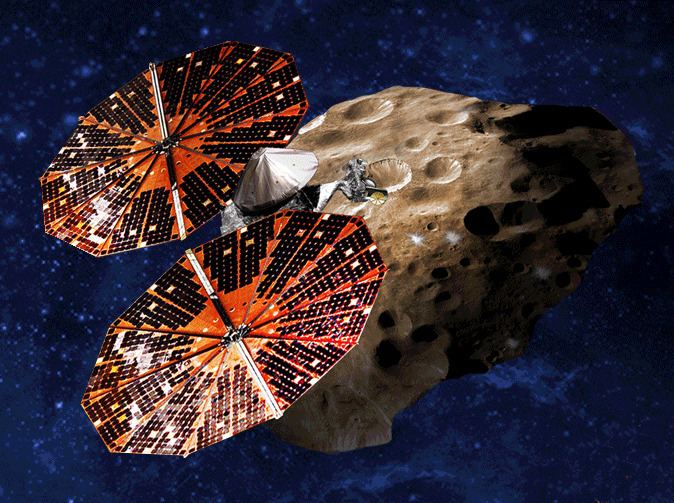Mission type Multiple-flyby mission Mission duration 12 years (planned) | ||
 | ||
Lucy is a planned American space probe mission that will tour six Jupiter Trojans (asteroids which share Jupiter's orbit around the sun, orbiting either ahead of or behind the planet.
Contents
On 4 January 2017, Lucy was chosen, along with the Psyche mission, as NASA's next Discovery class missions.
The mission is named after the iconic 'Lucy' hominin skeleton, because the study of Trojans could reveal the "fossils of planet formation": materials that clumped together in the early history of the Solar System to form planets and other bodies. The Australopithecus itself was named for a Beatles song, "Lucy in the Sky with Diamonds".
Overview
Lucy will launch in 2021 and will arrive at the L4 Trojan cloud (a group of asteroids that orbits about 60° ahead of Jupiter) in 2027, where it will fly by four Trojans, 3548 Eurybates, 15094 Polymele, 11351 Leucus, and 21900 Orus. After these flybys, Lucy will return to the vicinity of the Earth whereupon it will receive a gravity assist to take it to the L5 Trojan cloud (which trails about 60° behind Jupiter), where it will to visit two more Trojans, the binary pair 617 Patroclus-Menoetius. Lucy will also fly by the Main Belt asteroid 52246 Donaldjohanson, which is named for the discoverer of the Lucy hominin fossil.
Three instruments comprise the payload: a high-resolution visible imager, an optical and near-infrared imaging spectrometer and a thermal infrared spectrometer.
Harold F. Levison of the Southwest Research Institute in Boulder, Colorado is the Principal Investigator with Catherine Olkin of Southwest Research Institute as the mission's Deputy Principal Investigator. NASA's Goddard Space Flight Center will manage the project.
Exploration of Jupiter Trojans was one of the high priority goals outlined in the Planetary Science Decadal Survey.
Jupiter Trojans have been observed by ground-based telescopes and the Wide-field Infrared Survey Explorer to be "dark with ... surfaces that reflect little sunlight" Jupiter is 5.2 AU, about five times the Earth-Sun distance from the Sun (1 AU = 149 million kilometers = 93 million miles). The Jupiter Trojans are at a similar distance but can be somewhat farther or closer to the Sun depending on where they are in their orbits. There may be as many Trojans as there are asteroids in the asteroid belt.
Development
Lucy was submitted as part of a call for proposals for the next mission(s) for Discovery Program that closed in February 2015. Proposals had to be ready to launch by the end of 2021. 28 proposals were received in all.
On 30 September 2015, Lucy was selected as one of five finalist missions, each of which received 3 million USD to produce more in-depth concept design studies and analyses. Its fellow finalists were DAVINCI, NEOCam, Psyche and VERITAS.
On 4 January 2017, two of the five proposals—Lucy and Psyche—were selected.
Science payload
Instrumentation includes:
Targets
Targets with their flyby dates include:
